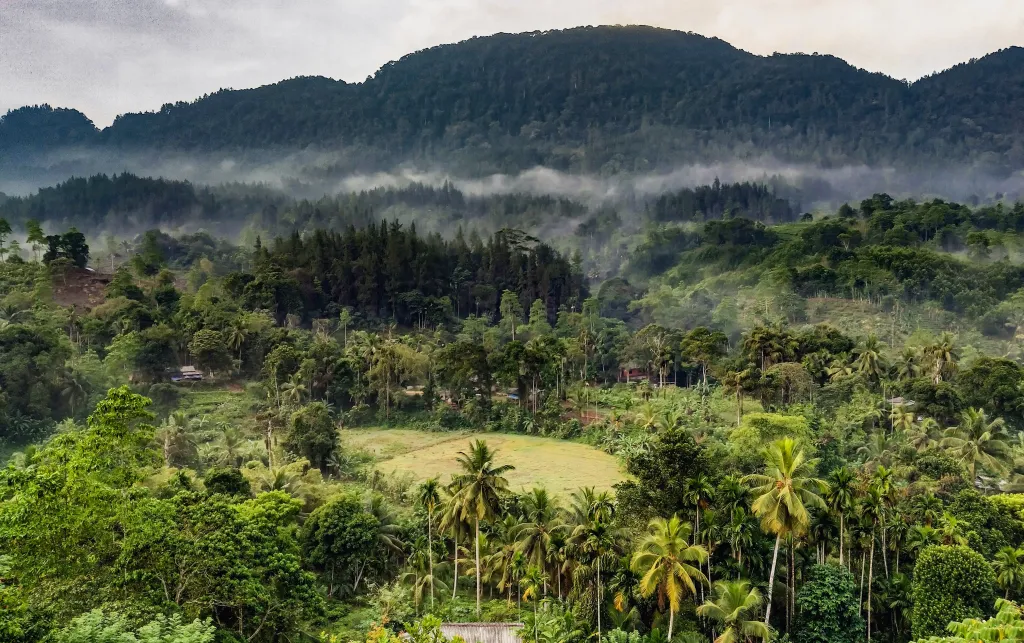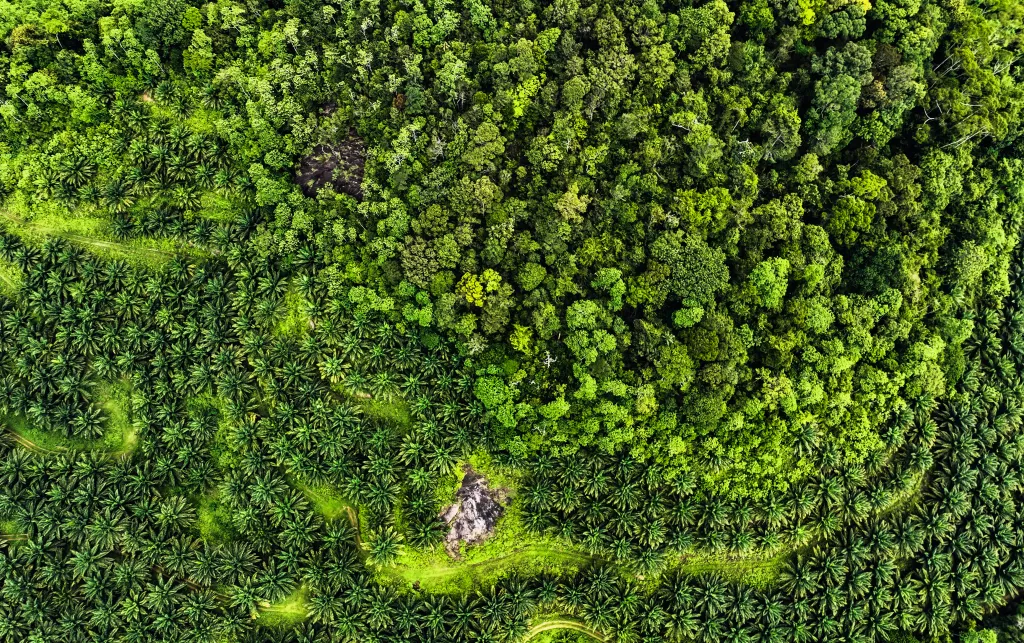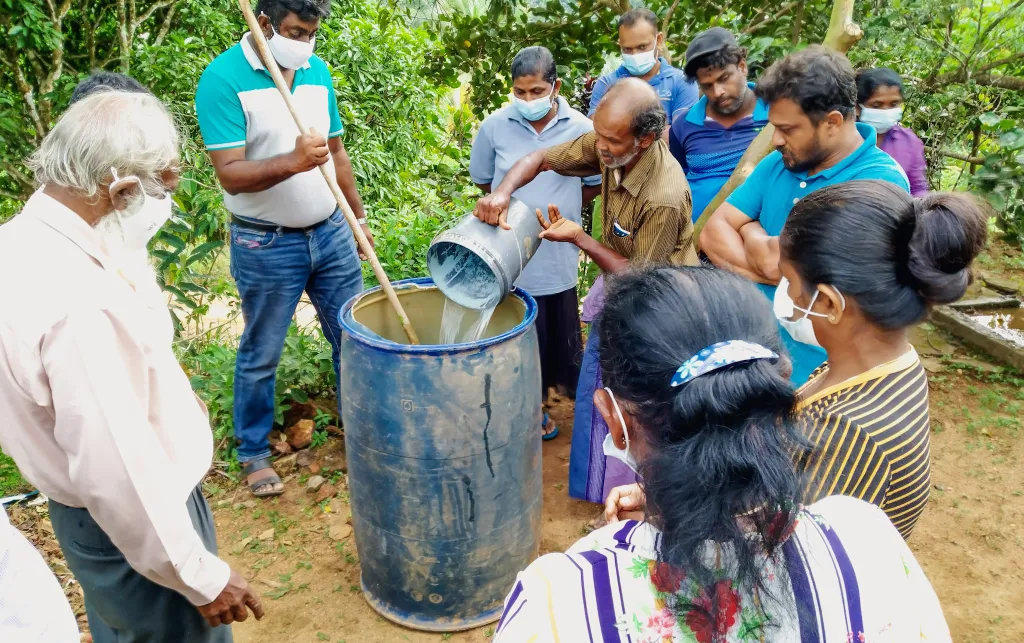6. Resisting land grabs in Sri Lanka
Peasants and other people living in rural areas have the right to land, individually and/or collectively […], including the right to have access to, sustainably use and manage land and the water bodies, coastal seas, fisheries, pastures, and forests therein, to achieve an adequate standard of living, to have a place to live in security, peace and dignity and to develop their cultures.”
Land grabbing across Sri Lanka for export-oriented agriculture and large housing development projects has accelerated since the end of the civil war in 2009, reaching epidemic proportions. Villagers have been evicted, as farm and forest lands are marked for tea, rubber, palm oil and banana plantations for export, export processing zones, and the development of tourist infrastructure such as all-inclusive hotels for mass tourism, all of which comes with huge environmental impacts.107
Land grabbing is not new: indeed, colonialism was one big land grab, and the reaction as part of decolonisation was to place the great majority of land under state control, with access by peasants and larger farmers working through a variety of customary and codified practices. Conflicts and military disputes that arose out of the civil war fuelled land grabbing, as people (and particularly the Tamil minority population) temporarily left their land for safety, making it easier for land to be stolen. As of 2016, farmers and herders had been forced from 36,371 hectares (approximately 140 square miles) of stolen land and compelled to move into the forests.108
The Movement for National Land and Agricultural Reform (MONLAR) is pushing back. MONLAR, a long-standing partner of War on Want, encompasses a network of grassroots farmer organisations, and works towards building a people’s movement for food sovereignty through capacity building and mobilising small farmers and marginalised communities. It protects natural resources and human rights, and as the representative of La Via Campesina in Sri Lanka, raises the voices of rural communities, persistently campaigning for agricultural and land policies that protect them, while promoting agroecological practices at village level.
One of MONLAR’s current campaigns focuses on the protection of nature reserves against expanding tea and palm oil plantations in southwest Sri Lanka, while defending the livelihoods of those living in and around the tropical rainforests.

Another campaign MONLAR has supported is against land confiscation and the blocking of natural water sources in the village of Homadola, next to the Kanneliya Forest Reserve (a lowland tropical rainforest in the south-west of Sri Lanka, protected by national regulations), by the management of the Homadola Estate. In 1912, during British colonial rule, areas of the Kanneliya rainforest were cleared to make way for a lucrative rubber plantation called the Homadola Estate, near the village of Homadola. Today, the Estate includes a palm oil plantation run by the Watawala Plantations corporation.
In 2004, the Kanneliya Forest Reserve was recognised by UNESCO as a Man and Biosphere (MAB) reserve – an important international recognition for sites promoting reconciling the conservation of biodiversity with its sustainable use. The Kanneliya Forest Reserve is one of the most biodiverse hotspots in South Asia: the forest contains over 300 species of rainforest wet-zone flora, 52% of which are endemic to Sri Lanka.
Despite the international recognition of Kanneliya and many similar protected areas in the country, illegal activities continue within Sri Lanka’s protected areas, including mining, poaching, human-induced forest fires, encroachment, monocrop cultivation, and the blocking of streams and rivers, preventing villagers and wildlife from accessing water. In addition, monoculture plantation models have widespread negative effects, such as the desiccation of natural water catchments, soil erosion, and chemical fertilisers and pesticides penetrating the aquifers (layers of rock, sand, or earth that contains water or allows water to pass through them).
Villagers in Homadola have the right to obtain water from natural water catchments in the forest-blanketed mountains of the Homadola Estate, regardless of whether land is under state or private ownership. Additional drinking-water projects jointly funded by the village and the Sri Lankan government provide water free of charge.
In April 2021, during the Covid-19 pandemic, the Estate management uprooted rubber trees to replace them with palm oil plantations, an example of how private corporations use moments of crisis to advance their interests. This new project gravely threatened freshwater catchments, sparking a large-scale conflict in the area.

After attempts to gain the attention and support of local government representatives were unsuccessful, villagers began to organise together. Banners highlighting the importance of protecting the environment were drawn and displayed near the Homadola Estate borders and fences, while others established an organisation called Praana (life) and contacted the media.
MONLAR contacted Praana members after seeing the media reports, and introduced the villagers to lawyers and environmental activists; alongside training the villagers in new methods and practices related to agroforestry and agroecology, to promote the protection of water sources and soil from damaging chemical fertilisers.

Meanwhile, the social and ecological situation deteriorated. Waste disposed from the palm oil-producing factory on the Estate, the Nakiyadeniya Factory, were dumped around the roads leading through Homadola, and chemical pesticides and factory waste now flows through the water supply, particularly during the rainy season when heavy rainfall washes the factory waste into freshwater sources. Villagers have reported increases in cancer, the deaths of young people from unknown diseases, and the disappearance of native animals, fish, birds and bees.
Due to irresponsible actions of the Estate, now the villagers get polluted water. Who knows what diseases we will get in the future by drinking this water? Most of the villagers don’t know what happens to their water sources because they live far away from the Estate. The pipelines laid in the Estate bring water to their households.”
Villagers met with one of the local authority representatives in mid-October 2021, to put forward their case for the Estate to ensure the protection of the forest areas and water catchments, or to let the villagers protect them. After this meeting, forest destruction has been temporarily stopped, although the future of the forest and water catchments remains uncertain.
As of 2022, the struggle around these issues continues, but villagers now are more hopeful that they can win this campaign with the support of MONLAR, and its network of lawyers, experts and activists.110
